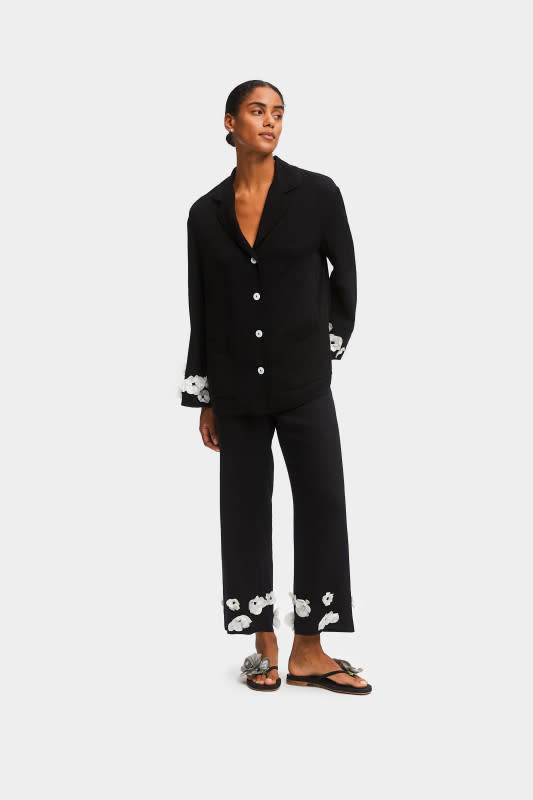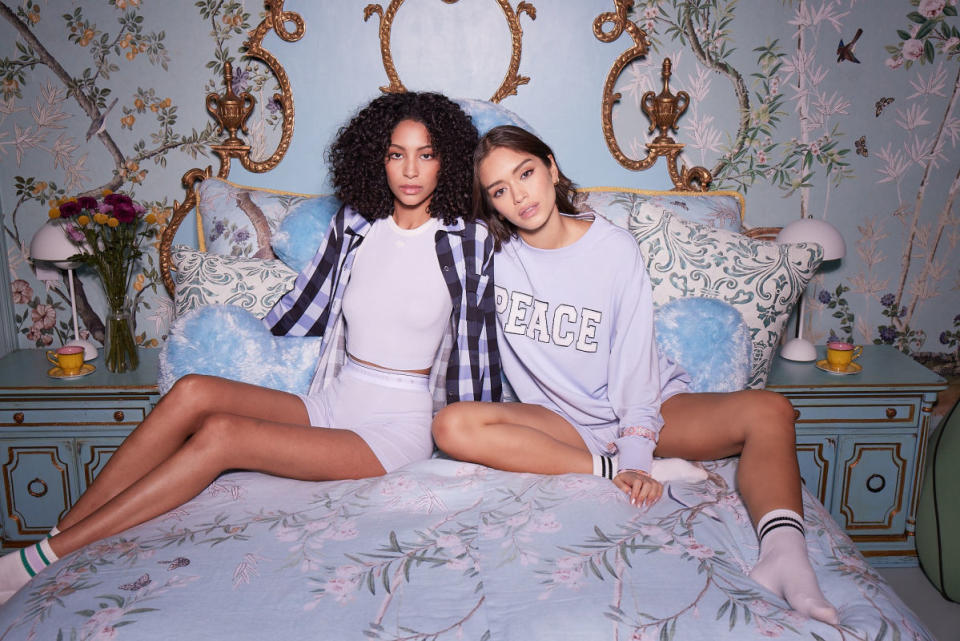How Brands Made Sleepwear Fashionable
Welcome to Sleep Week! We're dedicating five days of content to one of our absolute favorite activities, and the products that make catching zzz's that much more enjoyable. Get ready to sleep tight.
I was recently invited to a dinner party. The dress code: business casual. When I arrived, I counted at least three women clad in pajamas.
There was a graphic black-and-white printed set, another one crafted from sienna-colored satin that delicately refracted light and a floor-sweeping silk robe trimmed with feathers. Next to those who were outfitted in more formal attire — suits, cocktail dresses, etc. — the overall scene was a slightly incongruous one, but it nevertheless illustrated what's happening writ large: a sartorial era that's adamantly, resolutely rooted in comfort.
Obviously, clothing to sleep in has existed since, I'd venture to guess, the invention of garments. But it hasn't been more than that for so long — many of us got by with a sleep wardrobe consisting of vigorously worn-in college T-shirts or random merch tees falling apart at the seams. Only recently has sleepwear evolved into something far greater and grander than its original utilitarian purpose: an extension of personal style, an outlet of creative expression, an emblem of self-care, a byproduct of wellness manifested. And that has crept outside the confines of our bedroom walls.
Now, the lines between clothing worn outside, inside and in the bedroom have all blurred. As such, the category is growing: There's been a 29% increase in searches for sleepwear over the year on Lyst, says Barbara Janeczek, the curation manager of the global fashion search platform. And she's not at all surprised by the upward trend.
"The evolution of fashion trends mirrors societal shifts and changing lifestyle priorities," says Janeczek, who lists Skims, Eberjey, Tekla and Sleeper as the most-searched brands in the category. "In recent times, there has been a noticeable emphasis on well-being, self-care and comfort, especially given the challenges and uncertainties in the world. As individuals increasingly seek versatile clothing seamlessly transitioning from day to night, the sleepwear category naturally experiences growth."
Last year, the global sleepwear and loungewear market size was valued at $63.35 billion, and is projected to reach $82 billion by 2030, according to Verified Market Research. Even without the stats, its presence is inescapable, whether that be through persistent social media ads (or at least that's what my algorithm serves me) or the launch of new sleepwear brands, like Stacey Bendet's Big Feelings, Macy's State of Day or Clementine Sleepwear, joining the robust roster of established lines like Lunya, Hill House, Sleeper, Comme Si, Sleepy Jones, Lake and Araks. These days, you'd be pressed to find a brand without some version of sleepwear or loungewear.

Photo: Courtesy of Sleeper
The pandemic is the obvious catalyst. For non-essential workers, lockdown meant working remotely and restlessly spending days upon days indoors. Time slowed to a crawl; workwear hung listlessly, purposelessly in closets. Soft pants became the new uniform, and, strapped with disposable income that would have ordinarily gone to clothing worn outside, consumers were now spending that on loungewear of all kinds, from sweatsuits in every color imaginable to souped-up pajama sets.
The first that immediately springs to mind is Sleeper's signature feather-cuffed set or, as it's adoringly named, "Party Pajamas." "Every media outlet was writing about it — we were featured in every 'what to wear to work from home' story," says Asya Varetsa, cofounder of Ukrainian brand Sleeper. "When you're working from home, you don't need to dress up like you would at a corporate job, but you need something that's more dressed up than your regular pajamas."
Varetsa calls 2021 the brand's "unicorn year," with sales doubling in revenue, reaching $20 million."We were already organically growing, but that was the peak," she says. "When we started 10 years ago, Sleeper was unique on the market — sleepwear was either really sexual or basic pajamas with funny prints. For us, the idea was to make pajamas not for sleeping necessarily, but for going out in, this vibe of feeling comfortable outside."
The famous Nap Dress from Hill House shares the same idea: When Nell Diamond introduced the smocked style to the world in 2019, it quickly amassed an almost cult-like fan base.
"Our definition of the Nap Dress is any of our dresses with our proprietary smocking — it's super stretchy without stretching out. The idea was that it was comfortable enough — even if you happened to take an emergency nap," she says. "But the dress was always intended to be worn outside of that house, and have that dual purpose."
The sleepwear category has splintered into two: pajamas to be worn outside and pajamas to sleep in. The common thread is being comfortable.
"Let's pull back and look at what's happening on a macro scale: People used to wear suits to work, then khakis, then jeans, then athleisure," says Ashley Merrill, founder of Lunya, who started working on her immensely popular sleepwear brand in 2014. (Similar to Sleeper, Lunya also saw sales double in 2020.) "The trend toward comfort has been 100-percent consistent over a long period — decades, really. The pandemic catapulted us forward 10 years, but it was happening anyway. Now, it's become socially acceptable to prioritize comfort."
It's fair to say that the next step in the evolution — the next big movement after athleisure — would be "sleepleisure." Already, we're seeing it in the real world: High schoolers (and middle schoolers, too, according to my friend who's a teacher) are wearing pajama pants to school. In streetwear, it's not at all uncommon to throw on a blazer or a structured coat over sweats or style a going-out top with, say, a pair of boxers and cowboy boots. Chaotic, yes, but the good kind.

Photo: Courtesy of Macy's
Sleepleisure, restwear, innerwear — these are different words that all mean the same thing: pajamas, but better. There's an expectation that these clothes do more for you. That was the takeaway after Macy's spoke with 25,000 consumers, to inform and shape its new brand, State of Day.
"Women want products that do more than just [being] for sleeping in — we heard that they need pockets for their phones, they want more coverage so that they'd feel comfortable when they're around friends, or out to get the mail or to walk the dog. And the quality of fabrics needed to be improved," says Emily Erusha-Hillque, SVP of private brands for Macy's.
State of Day revolves around four fabric pillars based on consumer learnings: Breathe & Rest, with breathable cottons; Refresh & Rest, with naturally cooling properties like Tencel; Indulge & Rest, with luxurious silks and soft knits; and Smooth & Rest, with smoothing, seamless fabrics. "You can sleep in all [State of Day products], but you can also do all the things you love to do around the house," Erusha-Hillque says. "Women want clothes that are now synonymous with all activities throughout the day — it's a modern approach to dressing."
In addition to fabrication, design is just as important, especially when the intended purpose is sleeping. Merrill likens it to activewear: When you're working out, you want the support, the compression, the technical high-performance fabric that wicks sweat. "The same idea applies to sleep," she says, calling out Lunya's solution-oriented designs, like silk sets spun from machine-washable silk, straps that are cut in a way that won't fall off while you're asleep and pajama pants that feature a flat, non-slip waistband that won't add bulk or ride up, plus side slits for middle-of-the-night mobility.
This demand for superior quality sleepwear naturally coincides with our collective obsession with sleep: investing in so-and-so-count sheets, concocting sleepy girl mocktails, dabbling in sleep-aid supplements — anything to achieve that elusive "good night's rest."
"Culturally, as Americans, we used to pride ourselves in how little sleep we got and how hard we worked — and with smartphones, we were literally working all the time. As a society, we've shifted, we've had to build new boundaries, and it's changed our relationship with sleep," Merrill says. "The stigma has shifted from purported laziness to something that's a part of your wellness."
The idea of dressing for yourself — even to bed — has been Hill House's ethos from the outset. And it's struck a chord among consumers; the brand has seen consistent growth and continued demand in the eight years since launching.
"I feel so much better getting into a bed that's in my dream color palette in my favorite matching pajamas — that just helps me sleep better," says Diamond, who believes the demand for beautiful pajamas stems from a desire to express one's personal style. Some of her customers even match their bedding to their pajamas, a move that she calls "bedtime camouflage" (a phrase coined by her seven-year-old son).
"Sleep science experts will tell you that having an intentional set of pajamas, regardless of what you choose, is the best way to prepare your body to sleep," she says. "Our customer really wants to feel like herself, to feel and look cute — because, at the end of the day, fashion is entirely about them. Why wouldn't you put the same attention you put into what you wear outside as you do inside?"

Photo: Courtesy of Big Feelings
Even so, we have to give credit to social media and the role it plays in the sleepwear phenomenon: It's allowed a voyeuristic, intimate glimpse into other people's lives, from when they wake up to when they go to bed at night. Bendet believes that, so long as there's social media, there's going to be demand for "looking cute in all areas of your life," as she puts it.
The designer launched Big Feelings with the goal to foster a community and prioritize emotional well-being by incorporating uplifting messages and positive affirmations into collections, like sweatshirts with detachable friendship bracelets. (Each drop gives back to different mental health organizations.) "Sleepwear has become a huge part of 'get ready with me' social media culture," she says. "Consumers want the softest fabric, but also to look cute; they want sleepwear that can be worn as streetwear."
But social media isn't the only reason founders see this category as an ongoing business opportunity, citing simple human behavior as a growth driver. "I think we'll see continued growth, particularly when a trend, like sleepwear, is rooted in human preference," Merill says. "Not everyone works out, but everybody sleeps — and that's a pretty big business."
Diamond shares this perspective: "Everybody goes to sleep at night; our customer has always prioritized comfort, and that's always been one of our core tenets of everything we make. The business is only going to continue to grow — and I don't see it going anywhere."
Please note: Occasionally, we use affiliate links on our site. This in no way affects our editorial decision-making.
Never miss the latest fashion industry news. Sign up for the Fashionista daily newsletter.

